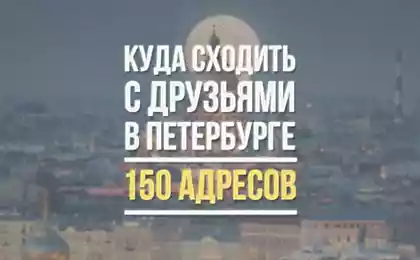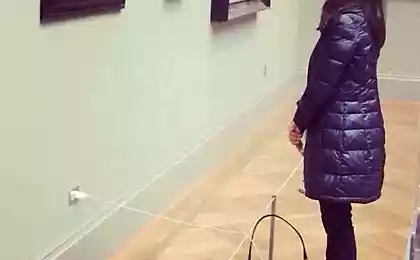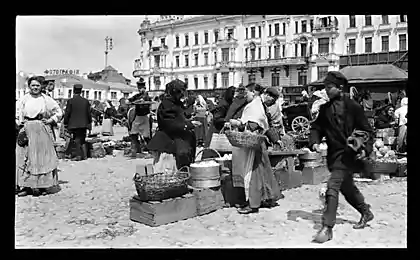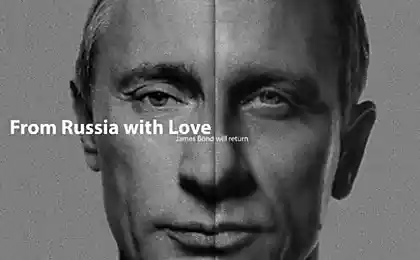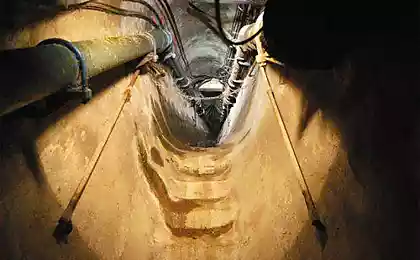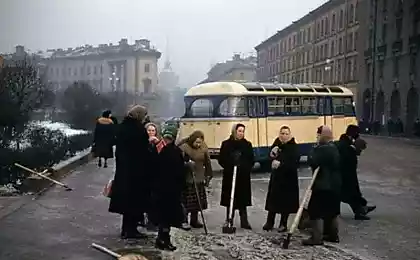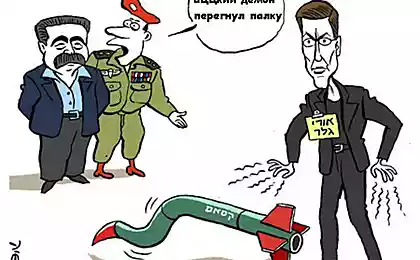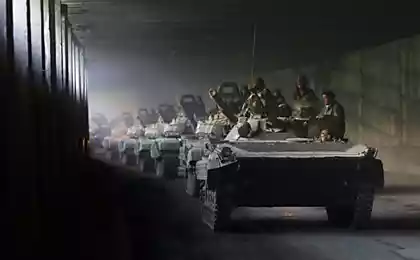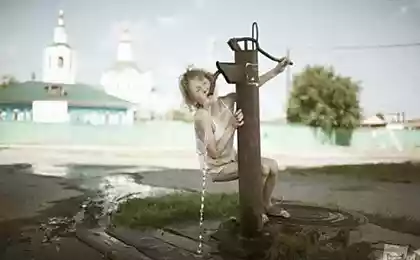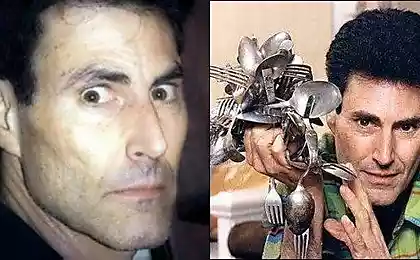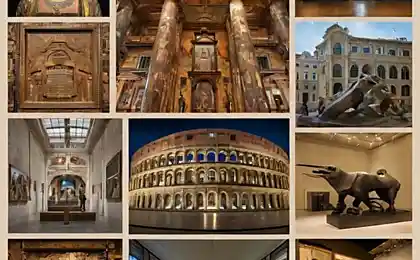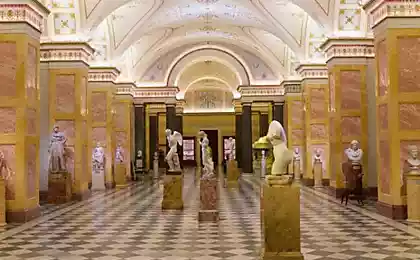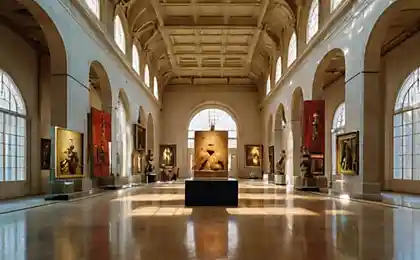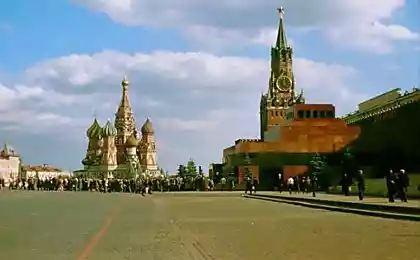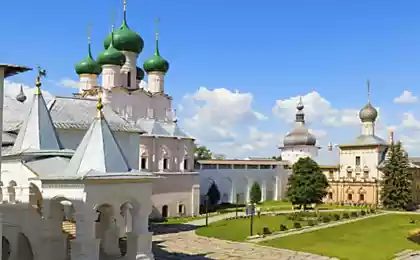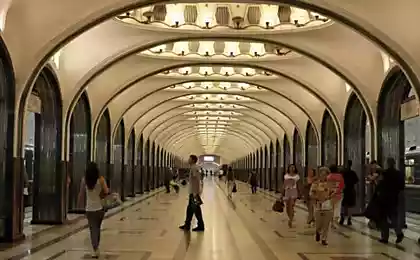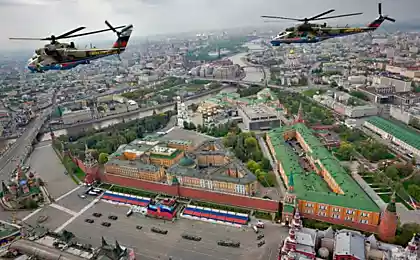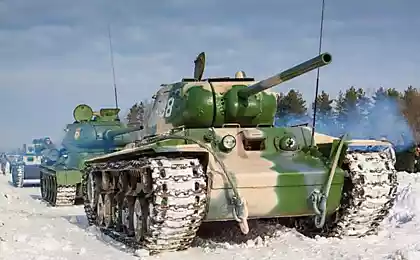2421
Museum of the Moscow Hippodrome
The proposed story about the history of the racetrack, its museum and some of the events that occurred on Running in different years. In recent years, architects offer their concept reconstruction of the territory CME changes here will inevitably occur, but yet there is a possibility for a few hours into the past.
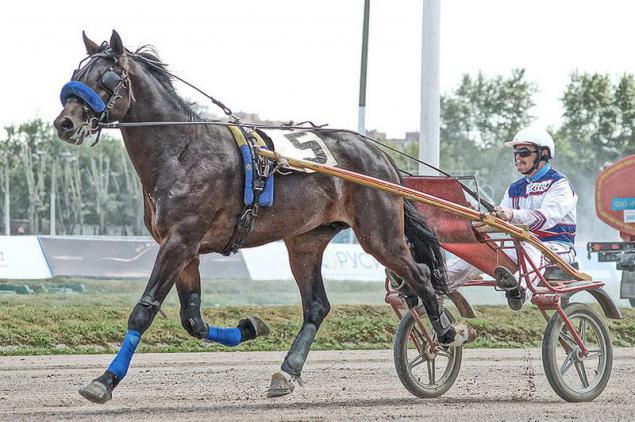
Central Moscow Hippodrome - one of the biggest racecourses Russia, the oldest in Europe, founded in 1834. In the years 1889-1894 was built Race Pavilion - the main building of the Moscow Hippodrome, designed by architects and Baryutina Kulagin. The building was renovated in 1950-1955-ies one of the most famous Soviet architects, academician Ivan Zholtovsky.
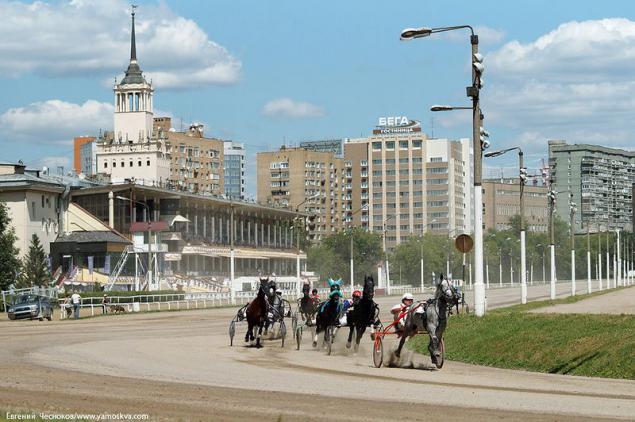
HISTORY
Previously, large areas in the vicinity of Running belonged Moscow Hippodrome. On Leningrad Prospect sculptures of Klodt, once it was the main entrance to the racetrack (graceful iron gates disappeared in an unknown direction during the reconstruction in 1965). Trotters can be found at the Petrovsky Park, the most distant stables were almost Belosrusskaya. At the turn of the highway on Khoroshevskoe preserved two-story building - a former hospital racecourse. Skakovaya on the street you can see the home race society and a beautiful mansion with a spire - House Mantashev horse breeders. Of the more modern buildings - hotel "Bega", but since 1990 it from the Racecourse otschipnuli.
Initially there were two racecourse - racing and trotting. The main building of the Trotting Racecourse then was called Moscow Race Pavilion (in its place and is the current CMR). Racing racetrack located close to the railway and in 1930 was demolished in connection with the reconstruction of the Belarusian railway station.
1901-1903 gg.
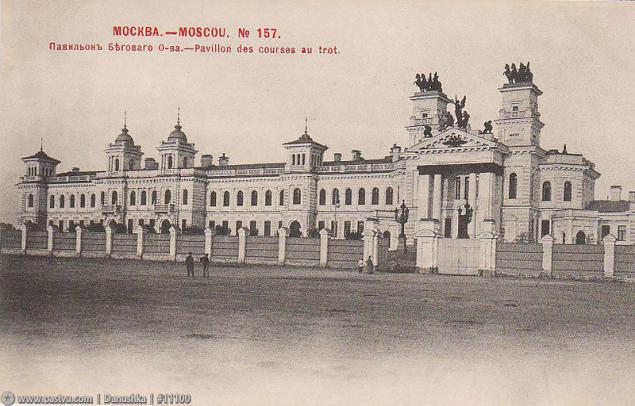
1896:
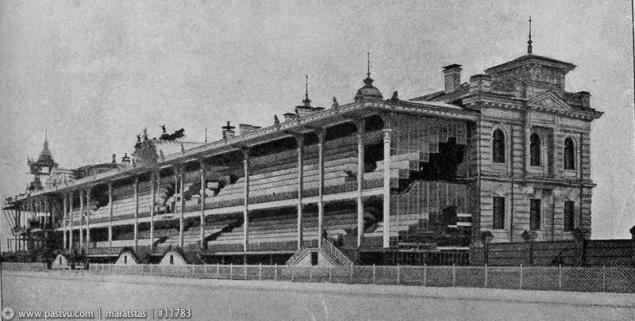
1930-1935 gg.
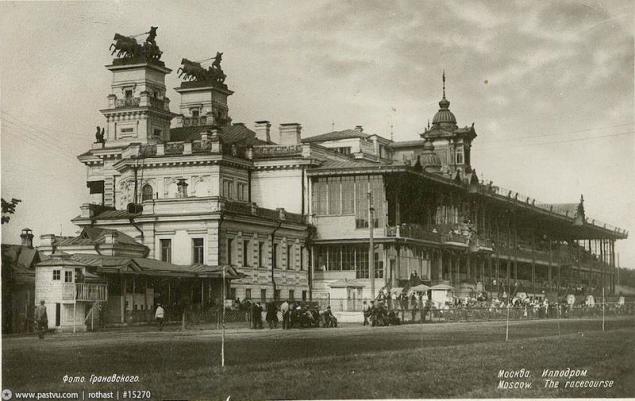
1970
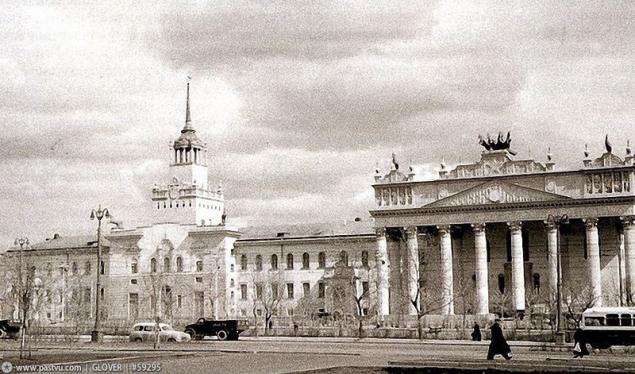
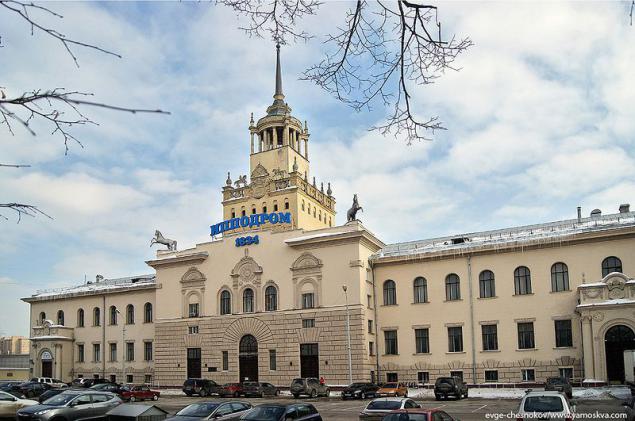
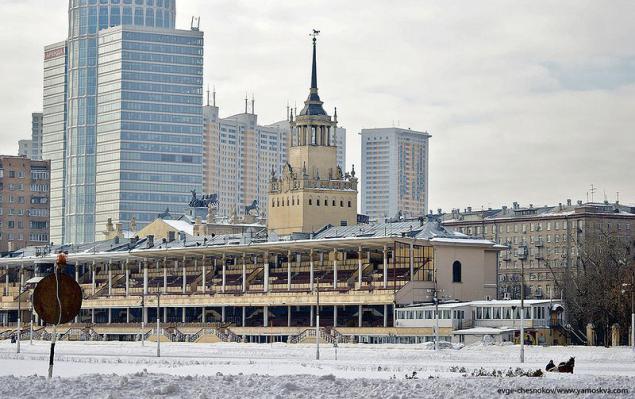
During the Great Patriotic War of breeding horses were evacuated to preserve the gene pool, and in the territory of the Hippodrome were gunners position guarding the skies over Moscow from enemy raids. In 1941, the director of the racecourse, the chief veterinarian, about one hundred employees - animal science, riders, jockeys went to the front dorovoltsami. Many never returned from the war. July 17, 1944 Muscovites showed Germans living - a column of several thousand prisoners of war held on the streets of Moscow under the escort of gunmen. Prior to this, revealing march prisoners were kept in the camp on the racecourse.
1943
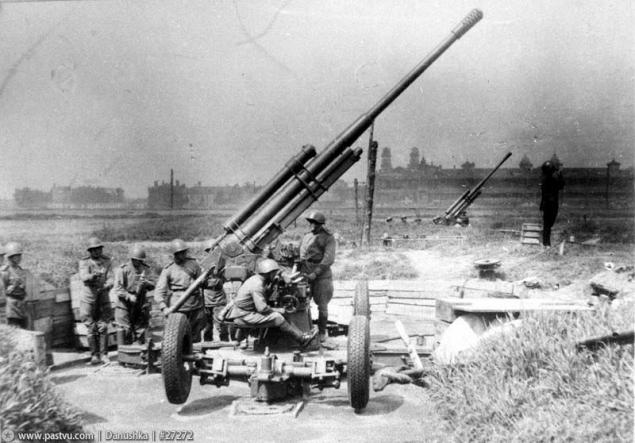
Already in 1944-1945 to resume testing at the Central Moscow Hippodrome. Tell an interesting story about the collective farmer-breeders from distant villages who wanted to show their horse on tests and on the way to the capital has overcome many difficulties, fighting off wolves, straying to the arboretum, but still made it to the Moscow Hippodrome. How frisky turned his horse, history is silent.
Once upon a time there was a continuous racetrack fence and into the 1960s, one of the trotters strove to explore the city, he ran away to Leningrad Prospect, on Tverskaya Street near the Kremlin and has already caught it.
In Soviet times, the run were extremely popular, trotting horses are established many records, and in the stands going the whole metropolitan bohemians. Gambling people an absolutely legitimate played here in tote, acting as much since 1877. In 2008, tote banned, but soon the ban was lifted. Novice to understand the rules of the game is not easy, without consultation with an expert can not do.
Post-Soviet period - not the most prosperous in the history of the CME. "Until now, Central Moscow Hippodrome, like most racetracks country was not in the best condition. Money he earned and almost drowning in debt. He even cut off electricity for the debts, "- wrote in 2011, chief editor of" Horse World "Natalia Kostikova. In the same year, Russian President Dmitry Medvedev signed a decree on the transformation of FSUE "Central Moscow Hippodrome" open joint stock company. 100% of the shares transferred to federal ownership, the priority of its activity was the development of horse breeding, horse racetracks and breeding of plants, as well as to create conditions for the totalizer and its integration into the international system.
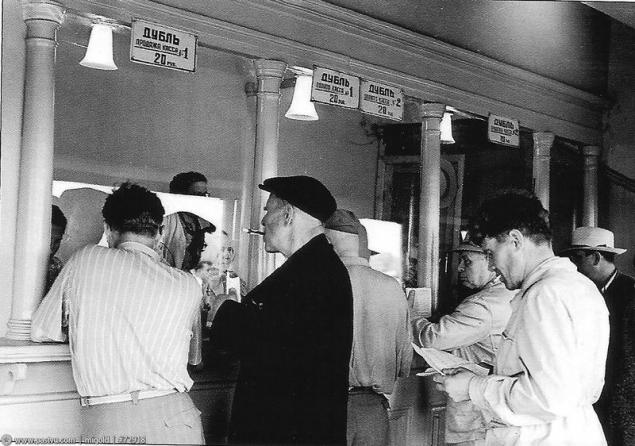
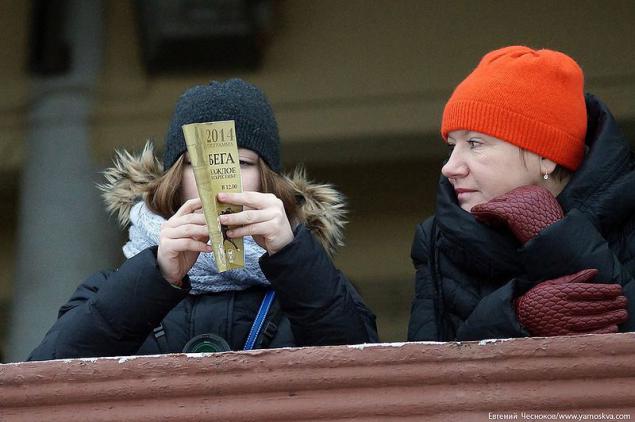
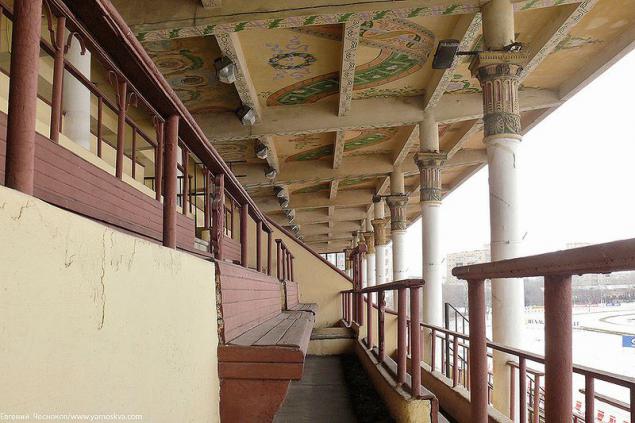
Rostrum designed for 3,500 spectators, before they are regularly filled to capacity these days in the city has increased every entertainment and a quorum at the racetrack going to the derby. So look stands and sixty-odd years ago. There are frescoes on the ceiling, stained glass windows, wooden benches for spectators. Log into the stands paid, the ticket price depends on the sector.

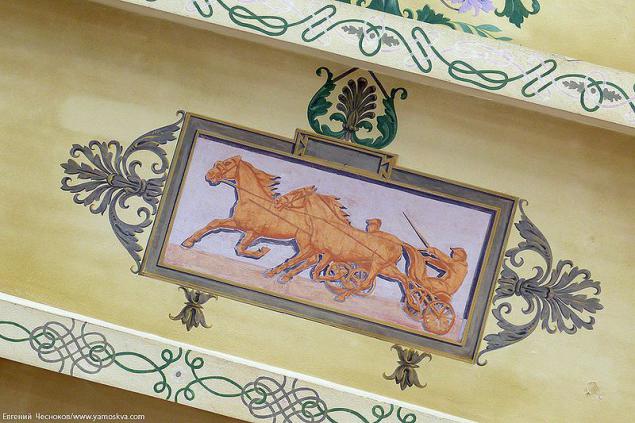
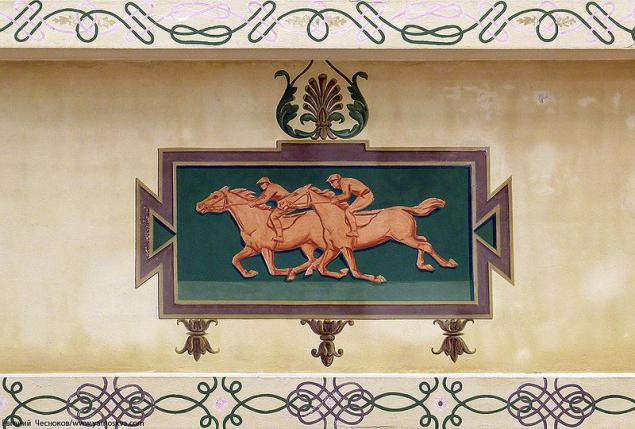
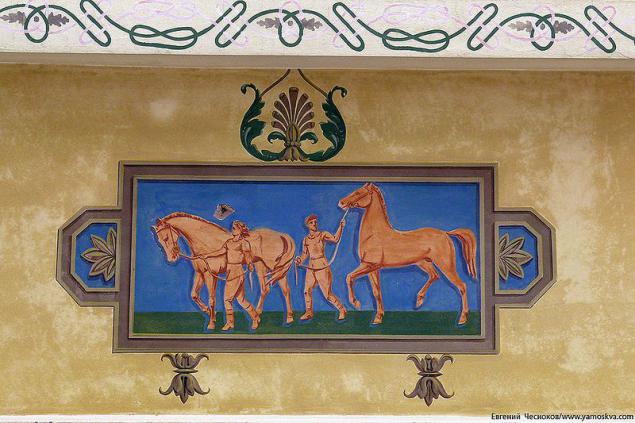
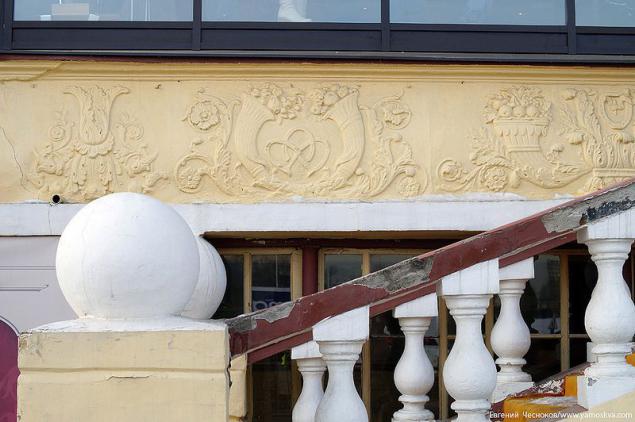

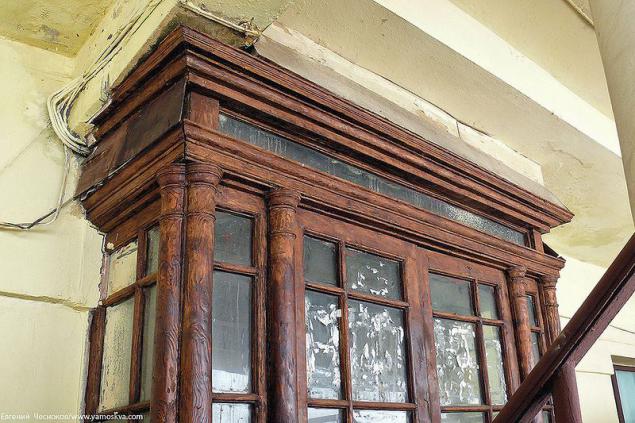
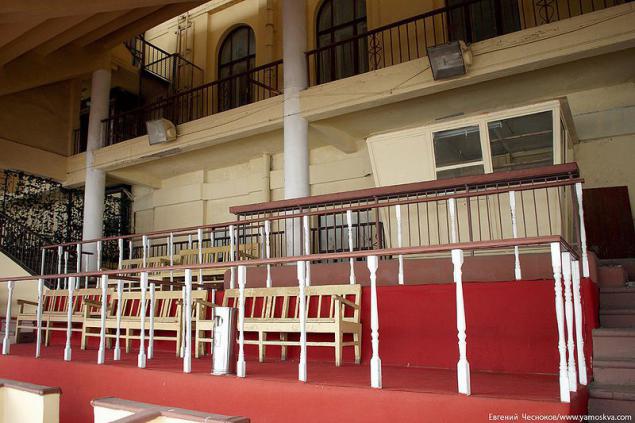
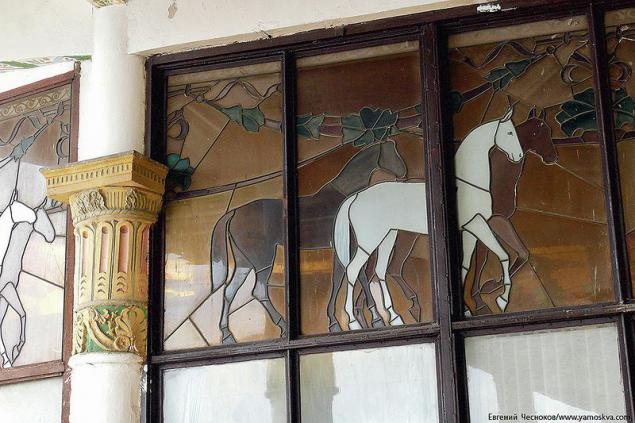

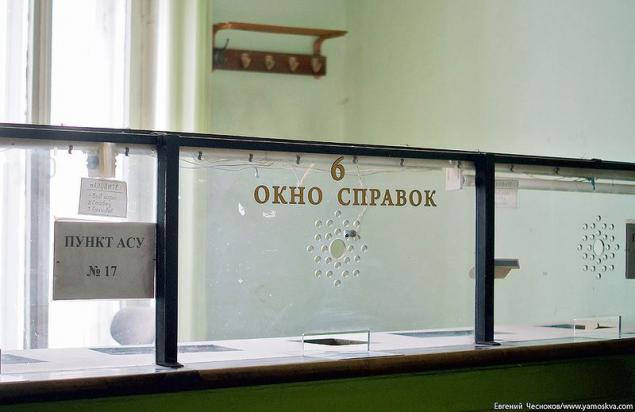
Entourage of 1950-1960 attracts cinematographers to shoot films and TV series from the life of the people to build communism. However, according to the writers, builders of communism in the run did not go among movie characters, visitors racetrack, dominated by criminal personality. In July 2014 there were filmed episodes of the detective series "Next." In fact, the audience is very different on the racetrack and his regulars were bohemians, artists metropolitan theaters. Say veterans of the Moscow Art Theater brought here young actors and taught bet. Nowadays here quite regularly can meet Alexander Shirvindt, and the entire metropolitan elite, flaunting festive attire, meets once a year to the races "Grand Prix Radio Monte Carlo."
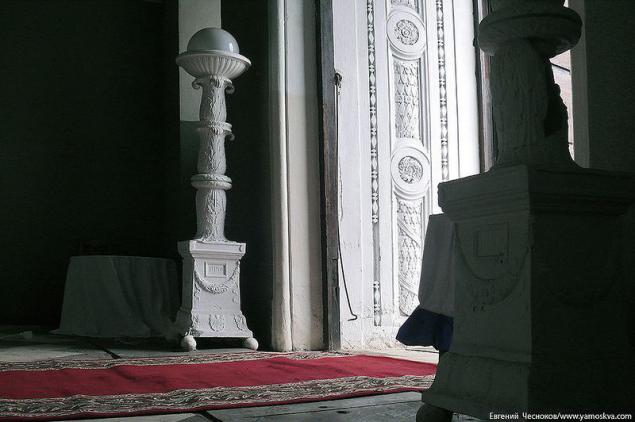
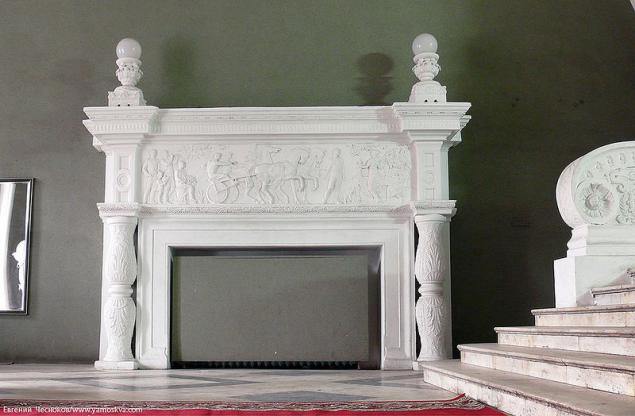
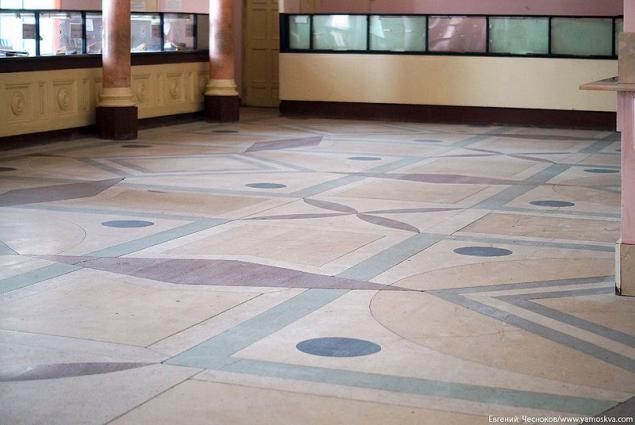

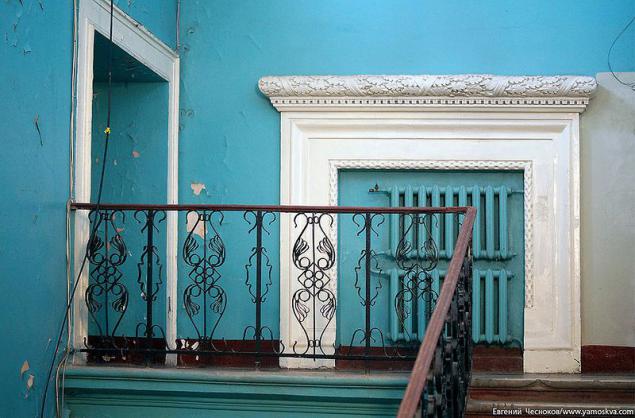
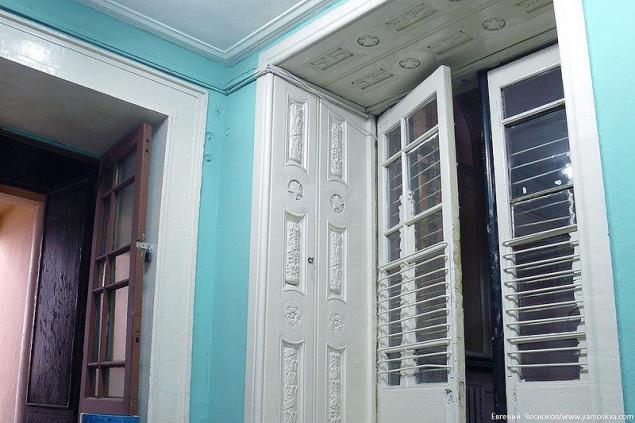
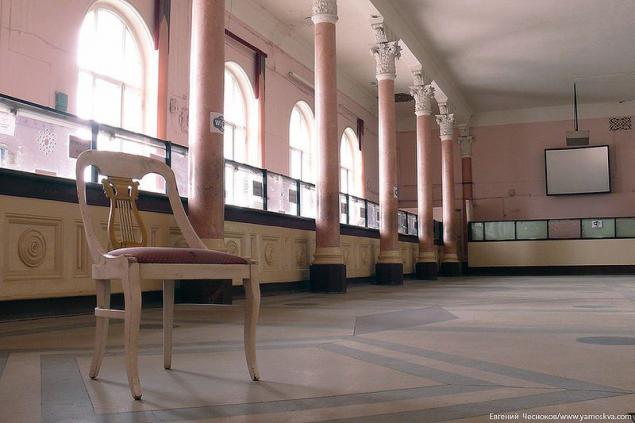
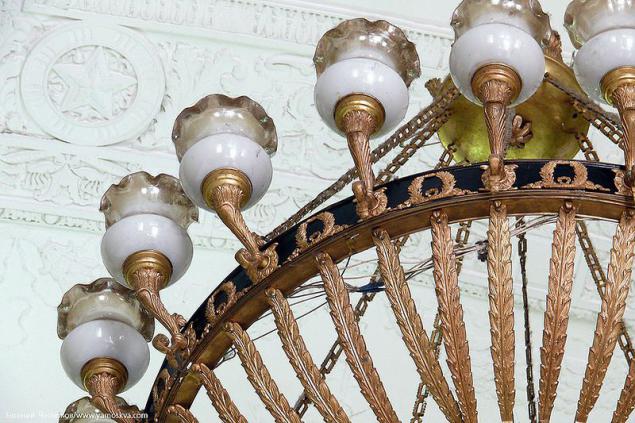
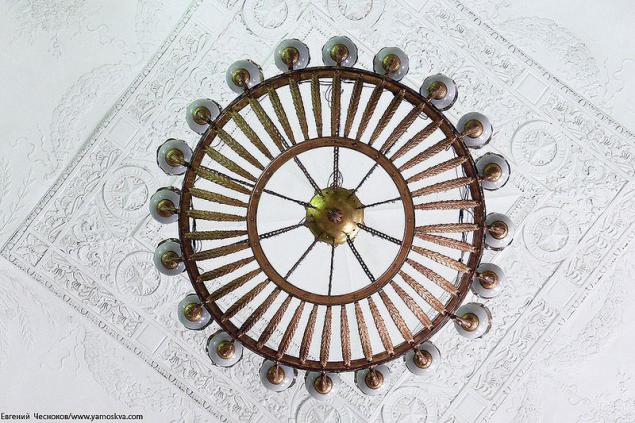
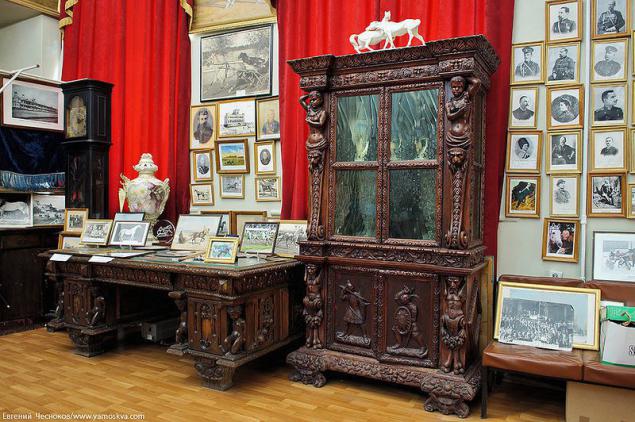
MUSEUM
At the Central Moscow Hippodrome has a small museum, it is usually closed, and to get into it, you must first talk to the employees, whose contacts are listed on the official website: www. cmh.ru/ The museum is housed in the old supposedly the director's office, the doors of which are in the gambling halls and pass-through can be accessed in any room racecourse.
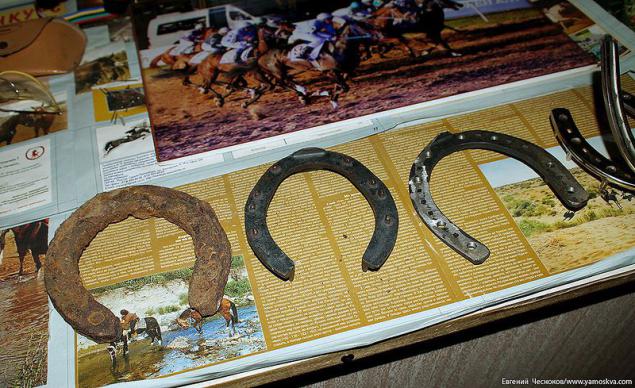
Among the exhibits horseshoe different years old is much more difficult today. Horse cleared once a month and a half (clearing gives hoof shape), if the horse during this time not to demolish a horseshoe nailed old. Winter horseshoe distinguished by the presence of thorns.
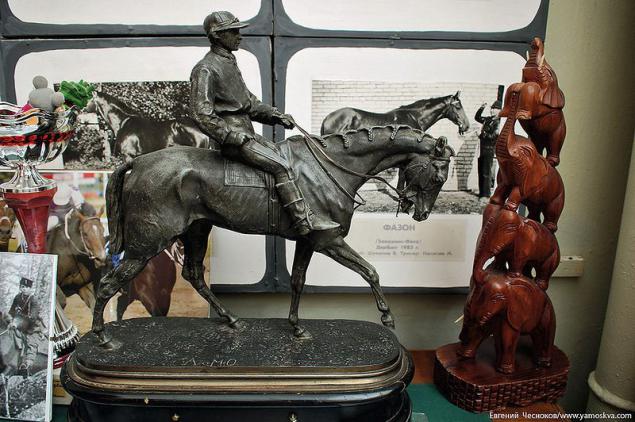
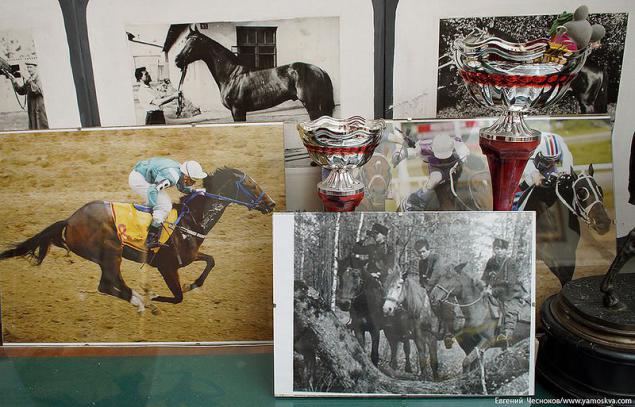
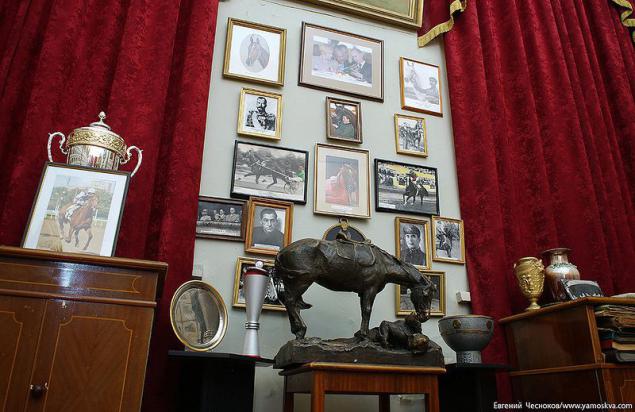
Portraits on the walls of Directors racecourse known livestock, famous athletes. Separately photos legendary horses Derby winner - and trotting race.
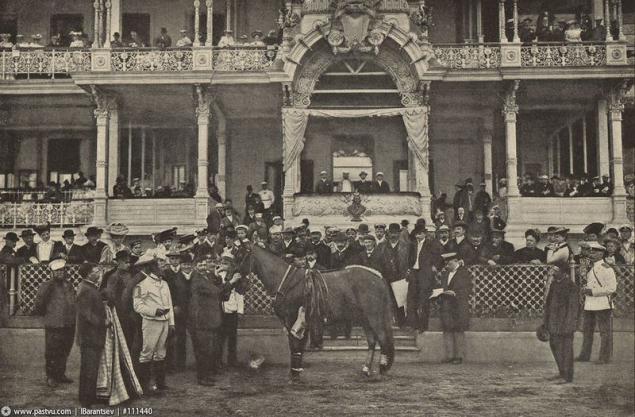
Perhaps S.N.Konshina - winner of the Grand Prize of All-Russia June 12, 1905 on a chassis racetrack: www.oldmos.ru/old / photo / view / 111440
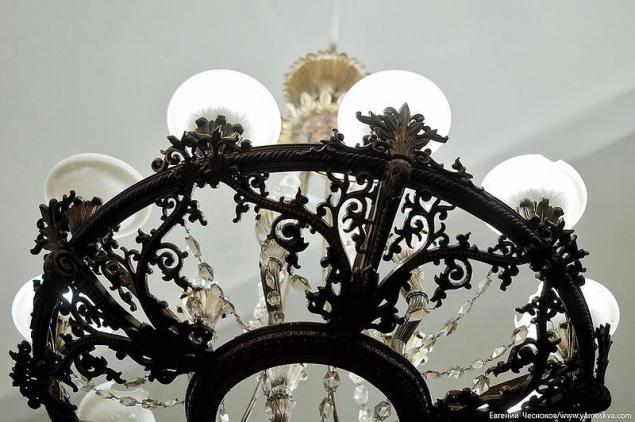
Furniture from Imperial Lodge has experienced several fires, moving from a racing racetrack, but eventually preserved as a museum piece. Chandeliers in the museum, too, from the imperial box. There is also a massive antique clocks in working order, but they are capricious and sometimes refuse to walk. All of these rarities were manufactured in XIX - early XX century. The museum and awards, cups winners of competitions.
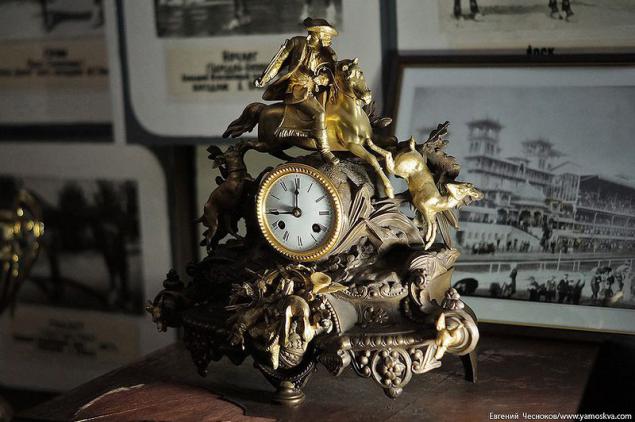
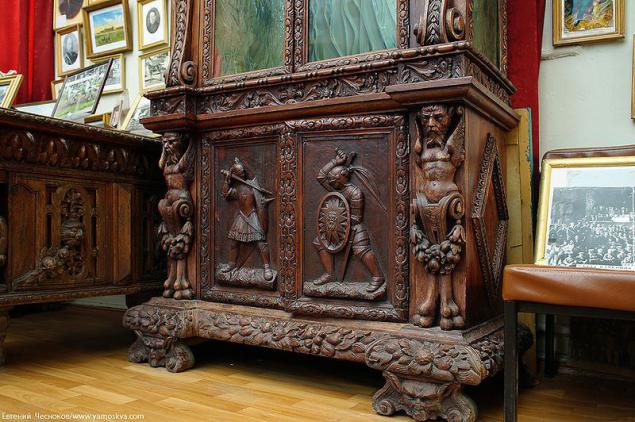
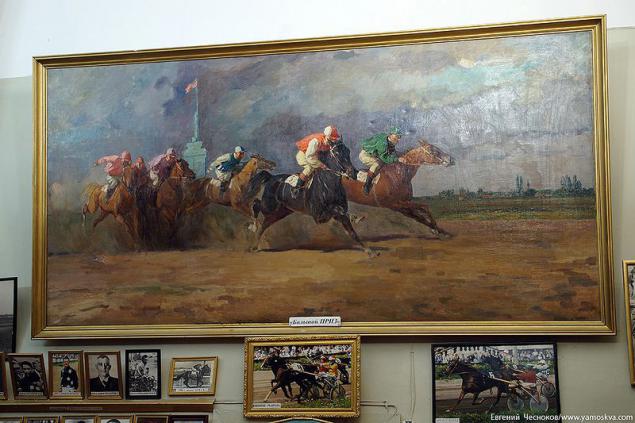
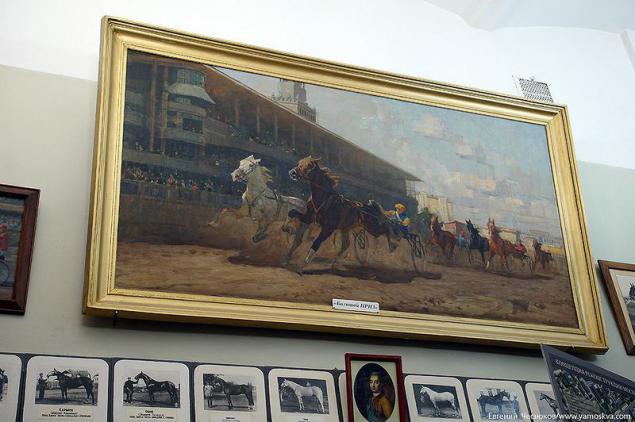
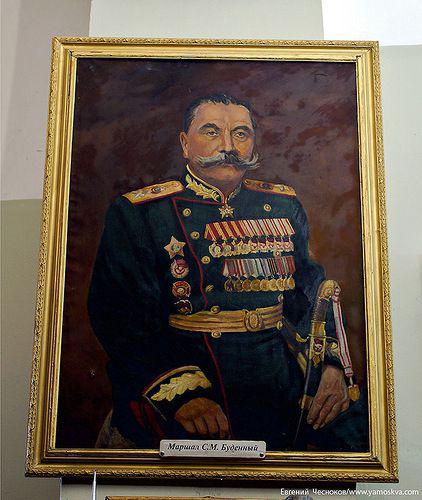
Marshal Semyon Budyonny played a significant role in the domestic horse breeding, well versed in the horses, took an active part in the creation of sports breed called Budionovskiy. This breed is bred in the post-war years, it occurred by crossing Thoroughbred horses and Don. Ideal for jumping and dressage. Semyon Mikhailovich and in old age was a frequent guest at the racetrack. According to legend, especially for him was set Elevators commander on the fourth floor, the directorate.
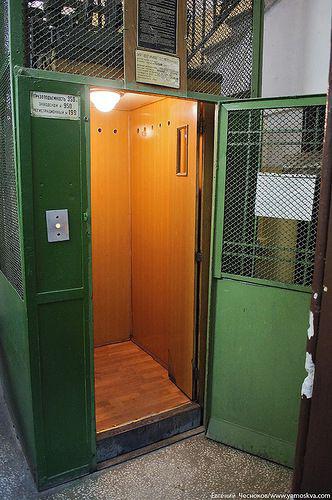
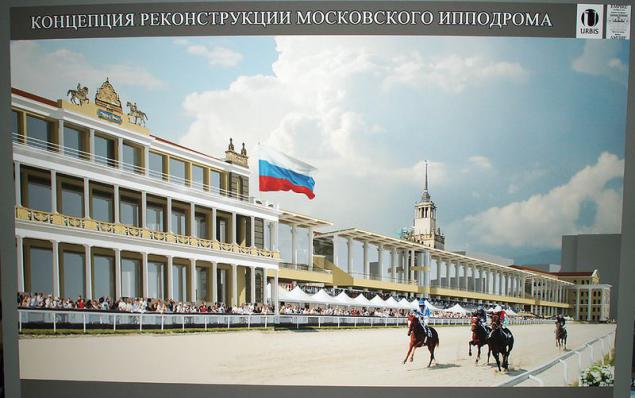
In the museum you can see the concept of reconstruction of the Central Moscow Hippodrome, presented in June 2014. This work was done with the participation of multiple stakeholders, taking into account the limited space of the existing site and the figures look quite attractive. In this project, confuse rather noticeable changes in the appearance of a historic building, for example, glazing spectator stands. It would be interesting to hear the views of experts in the field of architecture, but it is on the internet there is no such information.
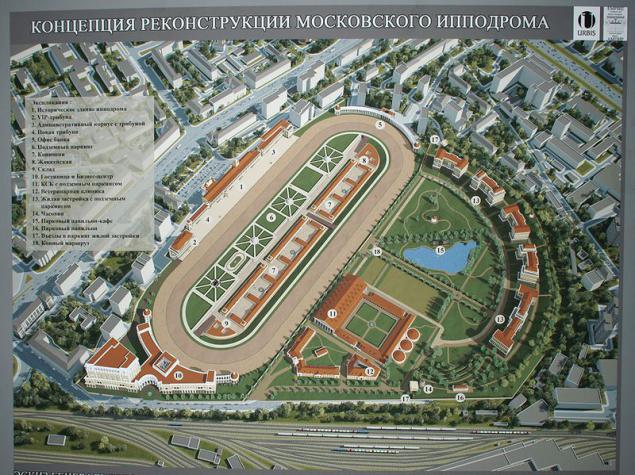
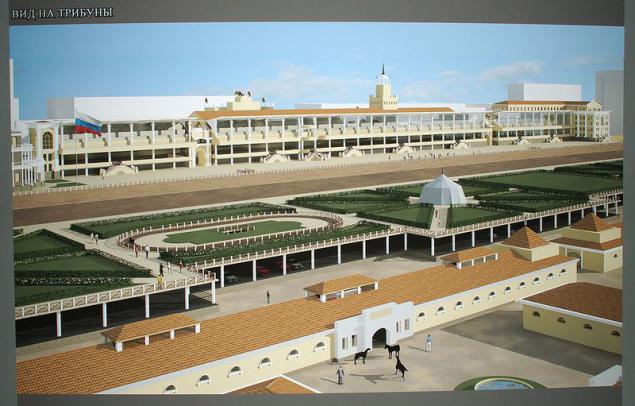
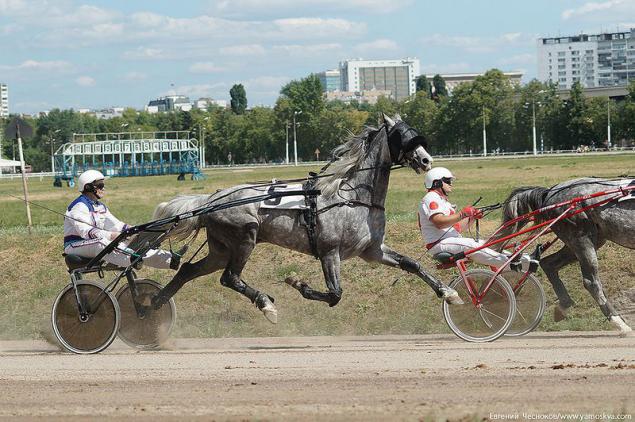
RUN
Every Sunday - and frosts, and in the July heat - citizens become spectators of races at the Central Moscow Hippodrome. Here are tested on horses frolic - run (test harness horses) and jumps (test riding horses).
The first run trotters in Russia started since 1776, when Count AGOrlov-Chesmensky began to experience their horses, the pioneers of Orlov trotter breed. Abroad, the first test of trotters in harness held in 1829. Even in those days the transition to canter was banned, the horse had to run only at a trot. If trotter goes into a gallop, it is called a "failure". In some countries, the failure immediately disqualify the horse. Under the Russian rider still has time to rectify the course of the horse.
Special car - autostart - aligns for a participants of arrival, distributes them according to the numbers and accelerates before starting to maximum speed. Autostart car was invented in the 1930s in the US, thanks to the start of such a process is almost impossible false starts and loss of time due to poor acceleration.
Start of arrival. 1968
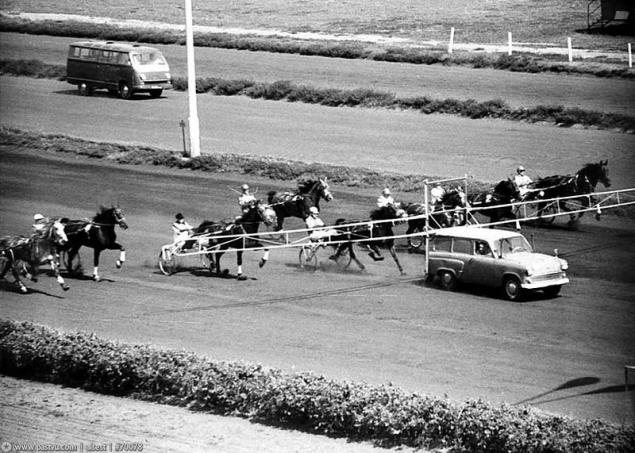
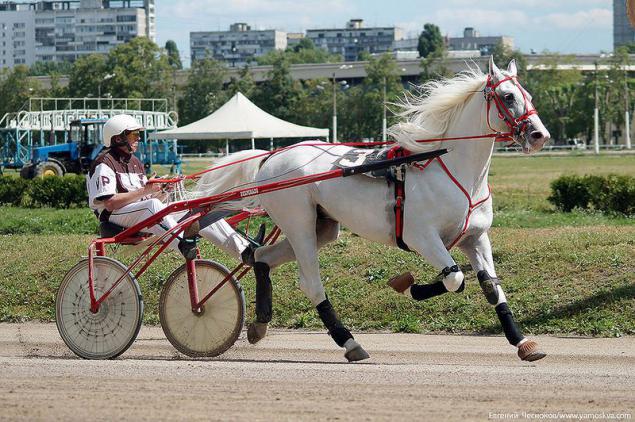

In order to understand the nuances of what is happening on the field spectacle correspondents YAMOSKVY consulted a press secretary Julia CMR Gareeva.
Interval from start to finish on the run is called a stop, at the races - the jump. The person who manages a horse on the run, called - rider in the race - jockey. The rider sits in a two-wheeled cart - rocking and jockey - in the saddle on a horse.
The standard distance race of 1600 meters, 1 mile, it's one lap race course. Tireless run Orlov trotters and 2400, and 3200 meters. This breed were taken not only as a sport, but also endurance. There are two prizes and trёhgitovye when the horse runs on the same day two or three runs with breaks for rest.
Russian arrivals occur and triple-drawn sleigh in winter, and in summer in the four-wheel carriage like the chaise. The team consists of three athletes, one controls the horse, two on the safety net for safety.
The camisole is given to the rider for life and he cherishes them. The rider can ride different horses, but camisole is always the same. Stars on it means the number of wins in the derby. In gear athlete also includes a helmet and a whip. For shoes no special requirements, pants with straps to be, there is a special clothing for racing, but in winter you can use a ski suit. Vehicle on the run, two-wheeled cart, called a rocker.
At any horse is a period of prosperity and recession period. There is also the voting age - for example, on the run according to the rules stallion can start up to 14 years. In Orlov trotters best period - four years, and racehorses early-maturing, they have career peak in three years. It is in these terms horses out at the start of the most important competitions - derby.
For athletes, there is no upper limit on age, so the rider Anatoly S. Kozlov and his 80 years continues to participate in the run. If the Olympic equestrian sports - show jumping, dressage - women a lot, on the run and race dominated by men.
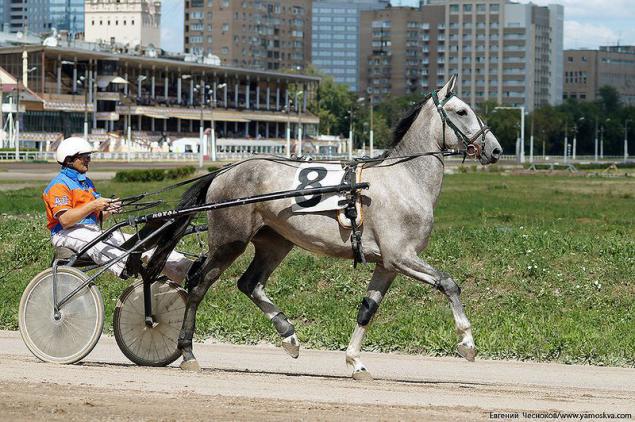
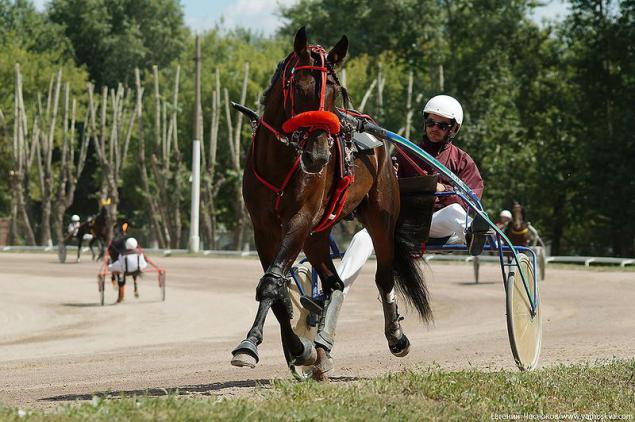
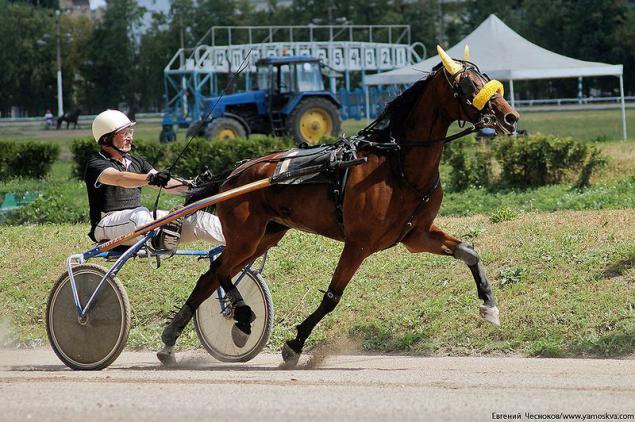
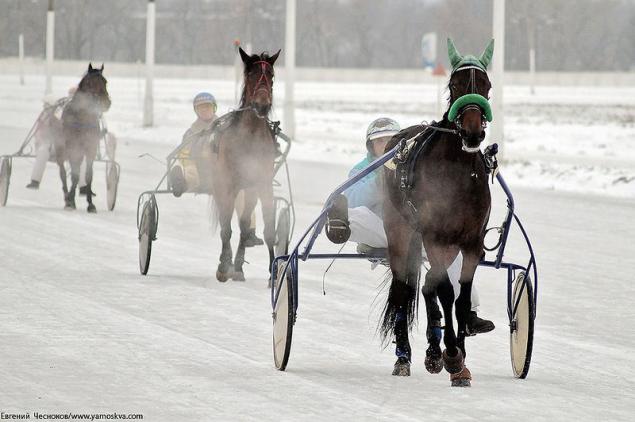
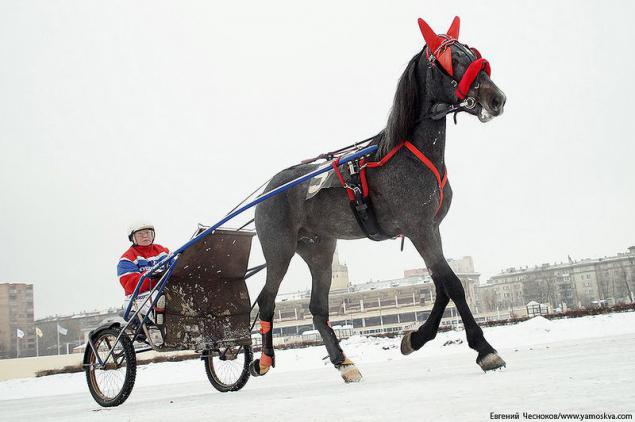
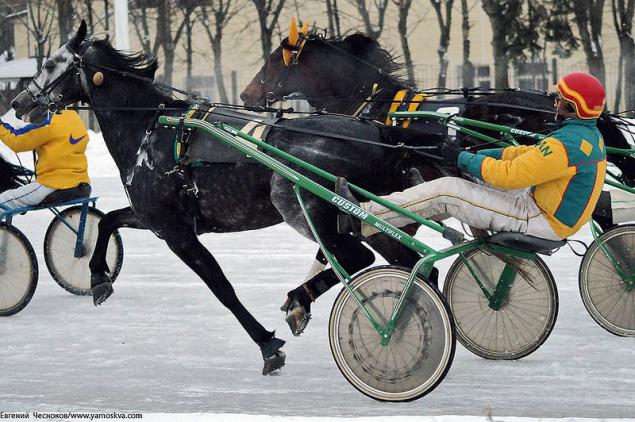
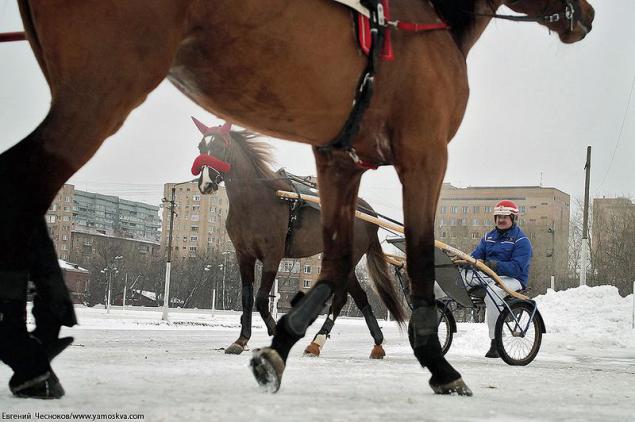
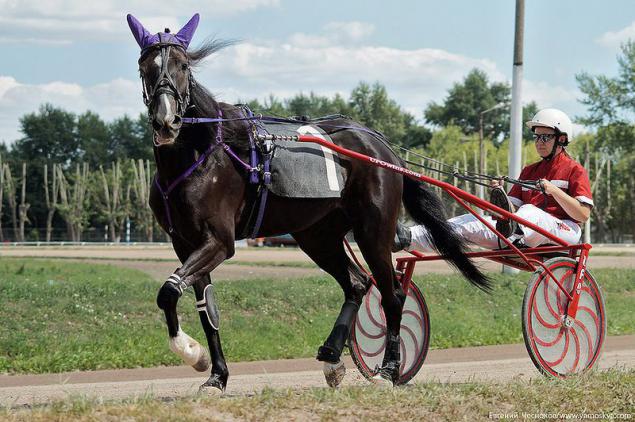
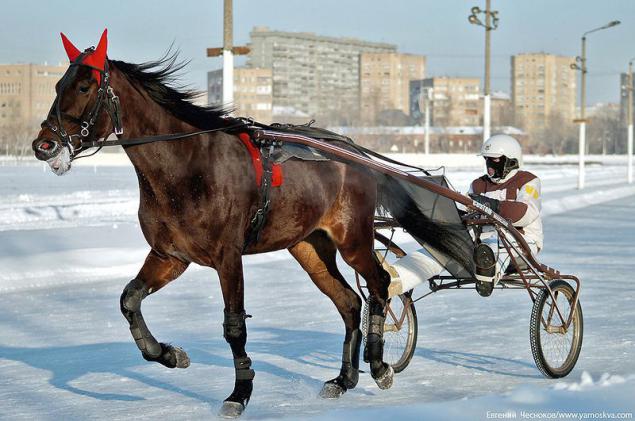
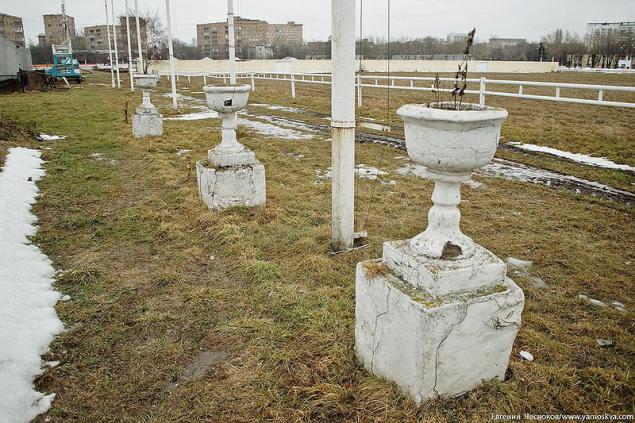
Field racetrack - this is a big oval with a concrete podium, bowls fountains, booths for staff and means for organizing horse races. Winter among the snowdrifts and ice are not very comfortable, but quite comfortable in the summer and even a fountain 1950s.
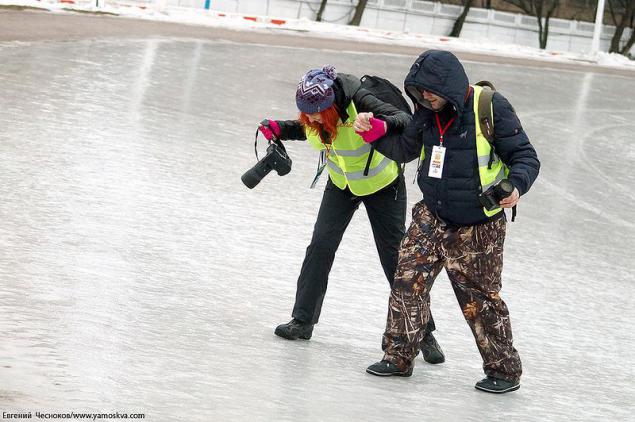
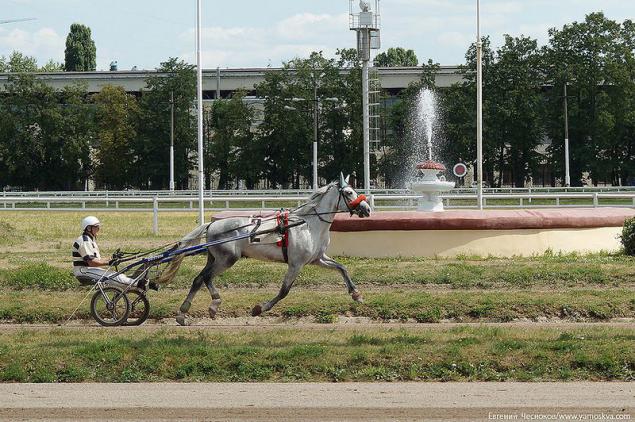
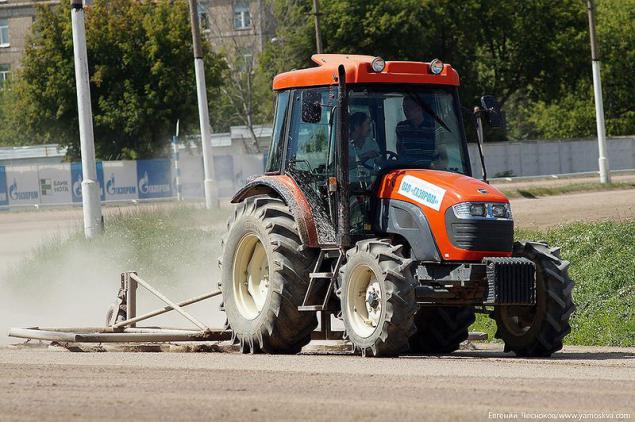
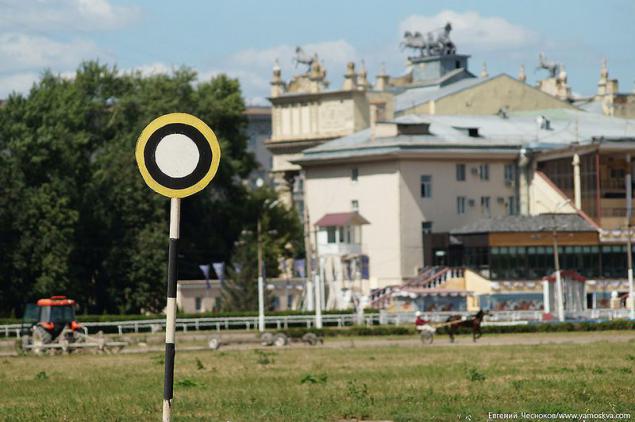

CARS
In addition to the horse races field in different years were used for road races, but in the early twentieth century, there were tournaments in wrestling, on "run walkers" are competing cyclists, demonstrated his skills early aviators. In September 1909 on a chassis racetrack hosted the first in Moscow demonstration flight by plane - in an airplane Voisin system, piloted by Frenchman Georges Legane. The show ended with almost a scandal, because the aircraft did not want to get in the air. In 1910 Utochkin was more successful flight on an airplane "Farman". Perhaps the strangest fun of that time was hounding wolves greyhounds in the photographs in 1916. In newsreels Dziga Vertov's 1926 sealed skiers, Red Army, which probably trained in the race field.
Check racing cars. 1961:
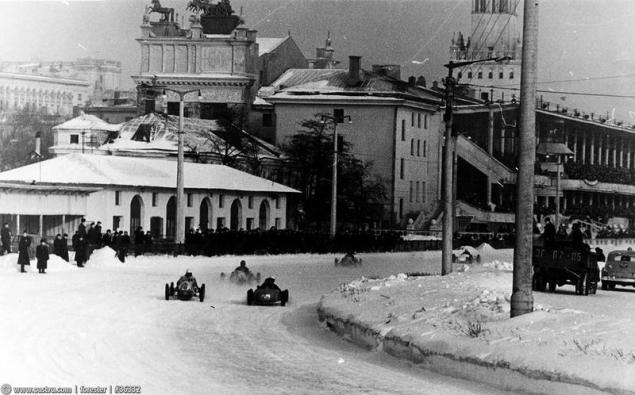
Winter USSR championship racing. 1971
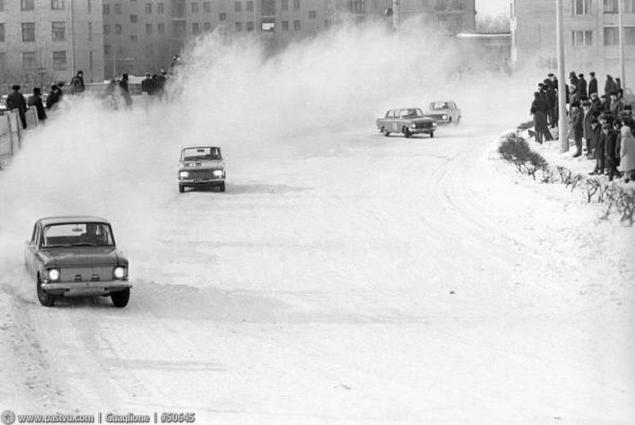
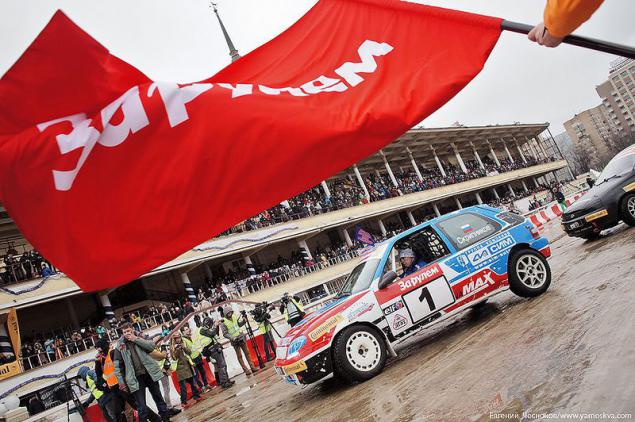
February 23 at the Central Moscow Hippodrome passes Race Stars "Driving", with the participation of the titled Russian athletes from various disciplines of motorsport and guest stars of Formula 1. In 2012-2014, in this traditional competition in exhibition races at Renault Duster launched Romain Grosjean (Lotus F1 Team), Charles Pic (Caterham F1 Team), Kimi Raikkonen (Lotus F1 Team), David Coulthard (vice-world champion in Formule- 1), Alain Prost (four-time world champion in Formula 1).
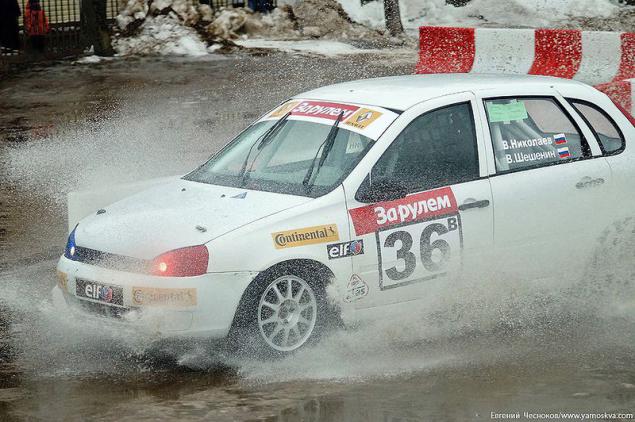
Romain Grosjean
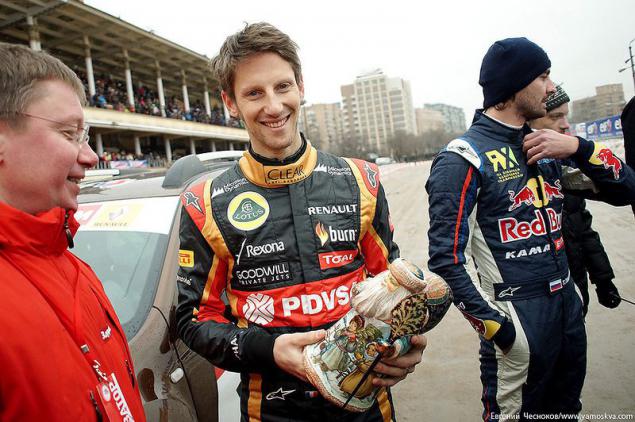
Charles Pic
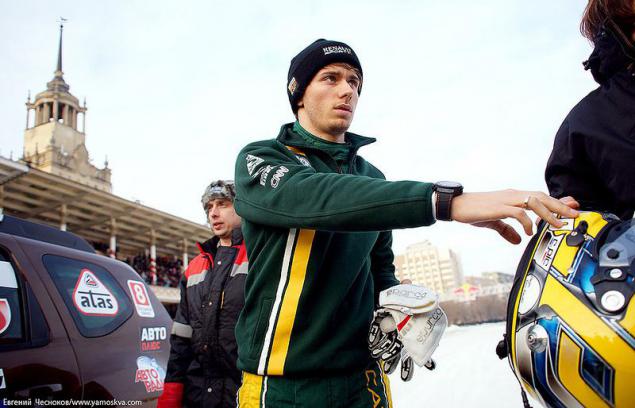
Kimi Raikkonen
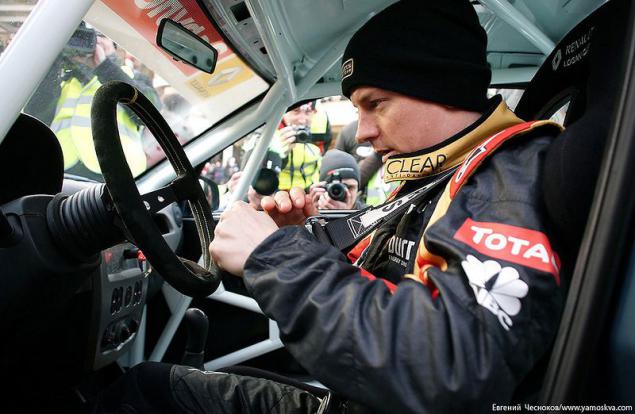
David Coulthard
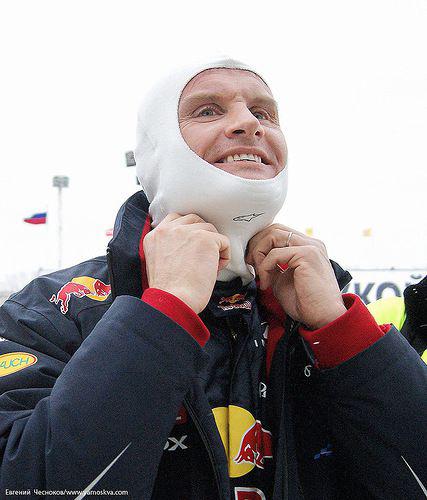
Alain Prost
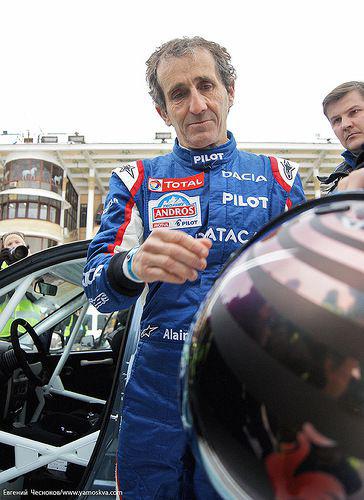
In the pauses between road races are the horses.
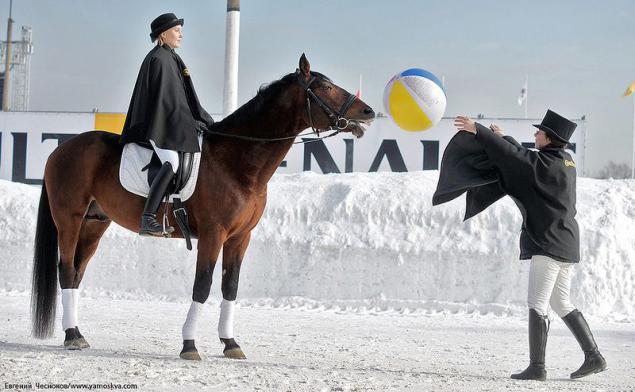

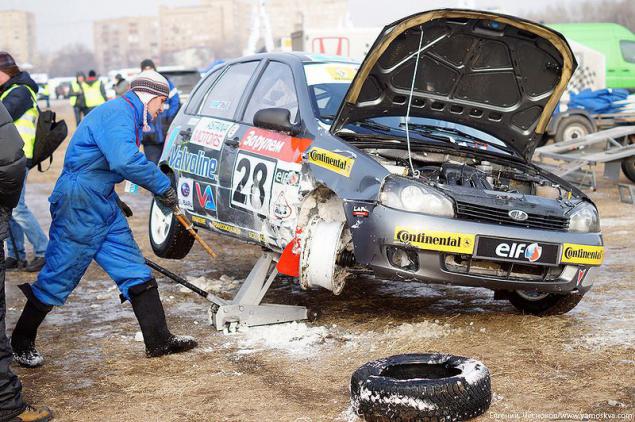
905 year

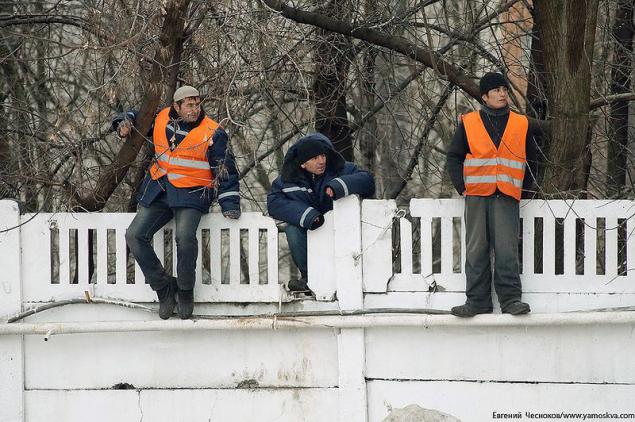
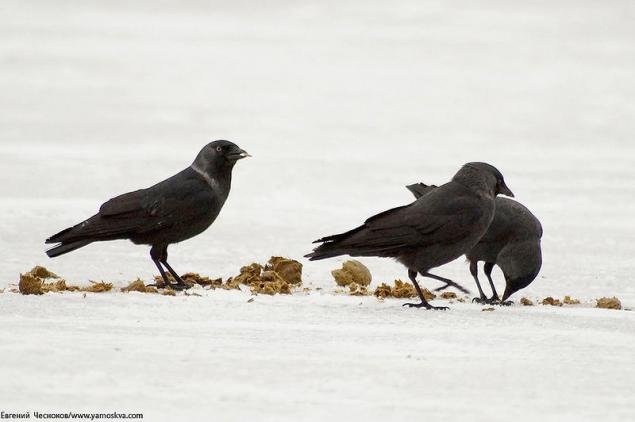
Source: evge-chesnokov.livejournal.com

Central Moscow Hippodrome - one of the biggest racecourses Russia, the oldest in Europe, founded in 1834. In the years 1889-1894 was built Race Pavilion - the main building of the Moscow Hippodrome, designed by architects and Baryutina Kulagin. The building was renovated in 1950-1955-ies one of the most famous Soviet architects, academician Ivan Zholtovsky.

HISTORY
Previously, large areas in the vicinity of Running belonged Moscow Hippodrome. On Leningrad Prospect sculptures of Klodt, once it was the main entrance to the racetrack (graceful iron gates disappeared in an unknown direction during the reconstruction in 1965). Trotters can be found at the Petrovsky Park, the most distant stables were almost Belosrusskaya. At the turn of the highway on Khoroshevskoe preserved two-story building - a former hospital racecourse. Skakovaya on the street you can see the home race society and a beautiful mansion with a spire - House Mantashev horse breeders. Of the more modern buildings - hotel "Bega", but since 1990 it from the Racecourse otschipnuli.
Initially there were two racecourse - racing and trotting. The main building of the Trotting Racecourse then was called Moscow Race Pavilion (in its place and is the current CMR). Racing racetrack located close to the railway and in 1930 was demolished in connection with the reconstruction of the Belarusian railway station.
1901-1903 gg.

1896:

1930-1935 gg.

1970



During the Great Patriotic War of breeding horses were evacuated to preserve the gene pool, and in the territory of the Hippodrome were gunners position guarding the skies over Moscow from enemy raids. In 1941, the director of the racecourse, the chief veterinarian, about one hundred employees - animal science, riders, jockeys went to the front dorovoltsami. Many never returned from the war. July 17, 1944 Muscovites showed Germans living - a column of several thousand prisoners of war held on the streets of Moscow under the escort of gunmen. Prior to this, revealing march prisoners were kept in the camp on the racecourse.
1943

Already in 1944-1945 to resume testing at the Central Moscow Hippodrome. Tell an interesting story about the collective farmer-breeders from distant villages who wanted to show their horse on tests and on the way to the capital has overcome many difficulties, fighting off wolves, straying to the arboretum, but still made it to the Moscow Hippodrome. How frisky turned his horse, history is silent.
Once upon a time there was a continuous racetrack fence and into the 1960s, one of the trotters strove to explore the city, he ran away to Leningrad Prospect, on Tverskaya Street near the Kremlin and has already caught it.
In Soviet times, the run were extremely popular, trotting horses are established many records, and in the stands going the whole metropolitan bohemians. Gambling people an absolutely legitimate played here in tote, acting as much since 1877. In 2008, tote banned, but soon the ban was lifted. Novice to understand the rules of the game is not easy, without consultation with an expert can not do.
Post-Soviet period - not the most prosperous in the history of the CME. "Until now, Central Moscow Hippodrome, like most racetracks country was not in the best condition. Money he earned and almost drowning in debt. He even cut off electricity for the debts, "- wrote in 2011, chief editor of" Horse World "Natalia Kostikova. In the same year, Russian President Dmitry Medvedev signed a decree on the transformation of FSUE "Central Moscow Hippodrome" open joint stock company. 100% of the shares transferred to federal ownership, the priority of its activity was the development of horse breeding, horse racetracks and breeding of plants, as well as to create conditions for the totalizer and its integration into the international system.



Rostrum designed for 3,500 spectators, before they are regularly filled to capacity these days in the city has increased every entertainment and a quorum at the racetrack going to the derby. So look stands and sixty-odd years ago. There are frescoes on the ceiling, stained glass windows, wooden benches for spectators. Log into the stands paid, the ticket price depends on the sector.











Entourage of 1950-1960 attracts cinematographers to shoot films and TV series from the life of the people to build communism. However, according to the writers, builders of communism in the run did not go among movie characters, visitors racetrack, dominated by criminal personality. In July 2014 there were filmed episodes of the detective series "Next." In fact, the audience is very different on the racetrack and his regulars were bohemians, artists metropolitan theaters. Say veterans of the Moscow Art Theater brought here young actors and taught bet. Nowadays here quite regularly can meet Alexander Shirvindt, and the entire metropolitan elite, flaunting festive attire, meets once a year to the races "Grand Prix Radio Monte Carlo."










MUSEUM
At the Central Moscow Hippodrome has a small museum, it is usually closed, and to get into it, you must first talk to the employees, whose contacts are listed on the official website: www. cmh.ru/ The museum is housed in the old supposedly the director's office, the doors of which are in the gambling halls and pass-through can be accessed in any room racecourse.

Among the exhibits horseshoe different years old is much more difficult today. Horse cleared once a month and a half (clearing gives hoof shape), if the horse during this time not to demolish a horseshoe nailed old. Winter horseshoe distinguished by the presence of thorns.



Portraits on the walls of Directors racecourse known livestock, famous athletes. Separately photos legendary horses Derby winner - and trotting race.

Perhaps S.N.Konshina - winner of the Grand Prize of All-Russia June 12, 1905 on a chassis racetrack: www.oldmos.ru/old / photo / view / 111440

Furniture from Imperial Lodge has experienced several fires, moving from a racing racetrack, but eventually preserved as a museum piece. Chandeliers in the museum, too, from the imperial box. There is also a massive antique clocks in working order, but they are capricious and sometimes refuse to walk. All of these rarities were manufactured in XIX - early XX century. The museum and awards, cups winners of competitions.





Marshal Semyon Budyonny played a significant role in the domestic horse breeding, well versed in the horses, took an active part in the creation of sports breed called Budionovskiy. This breed is bred in the post-war years, it occurred by crossing Thoroughbred horses and Don. Ideal for jumping and dressage. Semyon Mikhailovich and in old age was a frequent guest at the racetrack. According to legend, especially for him was set Elevators commander on the fourth floor, the directorate.


In the museum you can see the concept of reconstruction of the Central Moscow Hippodrome, presented in June 2014. This work was done with the participation of multiple stakeholders, taking into account the limited space of the existing site and the figures look quite attractive. In this project, confuse rather noticeable changes in the appearance of a historic building, for example, glazing spectator stands. It would be interesting to hear the views of experts in the field of architecture, but it is on the internet there is no such information.



RUN
Every Sunday - and frosts, and in the July heat - citizens become spectators of races at the Central Moscow Hippodrome. Here are tested on horses frolic - run (test harness horses) and jumps (test riding horses).
The first run trotters in Russia started since 1776, when Count AGOrlov-Chesmensky began to experience their horses, the pioneers of Orlov trotter breed. Abroad, the first test of trotters in harness held in 1829. Even in those days the transition to canter was banned, the horse had to run only at a trot. If trotter goes into a gallop, it is called a "failure". In some countries, the failure immediately disqualify the horse. Under the Russian rider still has time to rectify the course of the horse.
Special car - autostart - aligns for a participants of arrival, distributes them according to the numbers and accelerates before starting to maximum speed. Autostart car was invented in the 1930s in the US, thanks to the start of such a process is almost impossible false starts and loss of time due to poor acceleration.
Start of arrival. 1968



In order to understand the nuances of what is happening on the field spectacle correspondents YAMOSKVY consulted a press secretary Julia CMR Gareeva.
Interval from start to finish on the run is called a stop, at the races - the jump. The person who manages a horse on the run, called - rider in the race - jockey. The rider sits in a two-wheeled cart - rocking and jockey - in the saddle on a horse.
The standard distance race of 1600 meters, 1 mile, it's one lap race course. Tireless run Orlov trotters and 2400, and 3200 meters. This breed were taken not only as a sport, but also endurance. There are two prizes and trёhgitovye when the horse runs on the same day two or three runs with breaks for rest.
Russian arrivals occur and triple-drawn sleigh in winter, and in summer in the four-wheel carriage like the chaise. The team consists of three athletes, one controls the horse, two on the safety net for safety.
The camisole is given to the rider for life and he cherishes them. The rider can ride different horses, but camisole is always the same. Stars on it means the number of wins in the derby. In gear athlete also includes a helmet and a whip. For shoes no special requirements, pants with straps to be, there is a special clothing for racing, but in winter you can use a ski suit. Vehicle on the run, two-wheeled cart, called a rocker.
At any horse is a period of prosperity and recession period. There is also the voting age - for example, on the run according to the rules stallion can start up to 14 years. In Orlov trotters best period - four years, and racehorses early-maturing, they have career peak in three years. It is in these terms horses out at the start of the most important competitions - derby.
For athletes, there is no upper limit on age, so the rider Anatoly S. Kozlov and his 80 years continues to participate in the run. If the Olympic equestrian sports - show jumping, dressage - women a lot, on the run and race dominated by men.










Field racetrack - this is a big oval with a concrete podium, bowls fountains, booths for staff and means for organizing horse races. Winter among the snowdrifts and ice are not very comfortable, but quite comfortable in the summer and even a fountain 1950s.





CARS
In addition to the horse races field in different years were used for road races, but in the early twentieth century, there were tournaments in wrestling, on "run walkers" are competing cyclists, demonstrated his skills early aviators. In September 1909 on a chassis racetrack hosted the first in Moscow demonstration flight by plane - in an airplane Voisin system, piloted by Frenchman Georges Legane. The show ended with almost a scandal, because the aircraft did not want to get in the air. In 1910 Utochkin was more successful flight on an airplane "Farman". Perhaps the strangest fun of that time was hounding wolves greyhounds in the photographs in 1916. In newsreels Dziga Vertov's 1926 sealed skiers, Red Army, which probably trained in the race field.
Check racing cars. 1961:

Winter USSR championship racing. 1971


February 23 at the Central Moscow Hippodrome passes Race Stars "Driving", with the participation of the titled Russian athletes from various disciplines of motorsport and guest stars of Formula 1. In 2012-2014, in this traditional competition in exhibition races at Renault Duster launched Romain Grosjean (Lotus F1 Team), Charles Pic (Caterham F1 Team), Kimi Raikkonen (Lotus F1 Team), David Coulthard (vice-world champion in Formule- 1), Alain Prost (four-time world champion in Formula 1).

Romain Grosjean

Charles Pic

Kimi Raikkonen

David Coulthard

Alain Prost

In the pauses between road races are the horses.



905 year



Source: evge-chesnokov.livejournal.com
